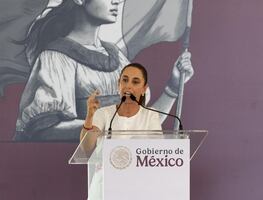Más Información

¿Maíz transgénero? Rubén Rocha corrige desliz durante discurso en Sinaloa; destaca importancia del maíz blanco

Sheinbaum asegura apoyo total a Sinaloa para enfrentar violencia; "Nunca los vamos a dejar solos, aquí está la presidenta"

Dictan 600 años de prisión a "El Negro" Radilla y "El Cone"; responsables de secuestrar al hijo de Javier Sicilia

Familias de desaparecidos en Mazatlán irrumpen en evento de Sheinbaum; mandataria promete atender peticiones

Sheinbaum responde a Trump sobre declarar a cárteles como organizaciones terroristas; rechaza injerencia extranjera
On April 10, after several years of hard work, a group of scientists from all over the world was able to capture the first image of a black hole.
The image was released all over the world, during press conferences held in the institutions where scientists collaborated to make this possible.
David Hughes
, the director of the Large Millimeter Telescope of Puebla , announced that a dozen Mexican scientists were part of the group of international scientists who worked to achieve the first image of a black hole , among them is Doctor Gisela Ortiz León , whose contribution made it possible for Mexico to be part of this historical achievement.
“I was very surprised and happy. The image obtained was very similar to black hole computer simulations, that meant we were doing things the right way,” said Dr. Gisela Ortiz about the first results obtained in 2017.
Dr. Ortiz studied physics at the UNAM and then specialized on radio astronomy and astrophysics . In October 2018, she was awarded by the International Astronomic Union for her doctorate dissertation .
In an interview with EL UNIVERSAL , Dr. Gisela Ortiz explained her involvement in the Event Horizon Telescope (EHT).
“They contacted me in 2013 when I was still doing my Ph.D. because I was specialized on interferometry . My work at the Large Millimeter Telescope was, in the beginning, to aid U.S. experts to adapt the Mexican telescope for the needs of the EHT ,” she explained.
In this project, interferometry was used to synchronize eight radio telescopes located all over the world. Using the earth's rotation , they formed a huge digital lens the size of our planet and as powerful as to allow a person located in New York to read a newspaper on the streets of Paris .
The Large Millimeter Telescope of Puebla (GMT) is the world's largest single-dish radio telescope and one of the most powerful telescopes in the world but it required some adaptations to be part of the ambitious project Event Horizon Telescope.
“The adaptation consisted of installing an atomic clock s ince each telescope observes in different ways and there has to be a way to register time more precisely when receiving the signal. Also, high-capacity disks were installed and specialized software ,” said the astrophysicist
Currently, Dr. Ortiz is working on her post-doctoral degree at the Radio Astronomy Max Planck Institute in Germany.
The scientist also voiced her concern in regards to the money that is being invested in astronomy in Mexico because although the Conacyt said there would be no budget cuts for this science, it prefers to benefit disciplines that create an immediate benefit for society: “Astronomy generates knowledge and undeniable benefits for society but its application is a long-term one, sometimes, the investigations we carry out take year to show concrete results. Many times, astronomy projects don't receive the necessary ( financial ) aid to move forward,” said the scientist .
gm






